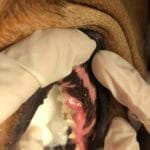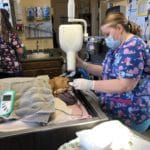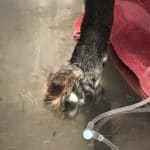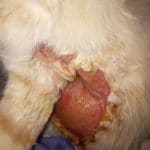Five days ago my 7year old German Shepherd was out side playing and running with my beagle puppy. Next thing I know she is yelping in pain and rolling around on the ground. By the time I get to her she has stopped crying out and is laying still. I realize both hind legs are paralyzed. We immediately take her to the vet and she is examined. She doesn’t appear to be in any pain and she DOES have deep pain sensation! She is immediately started on Steroids, Muscle Relaxers, and Anti Inflammatories. She remains at the vets for five days and receives cold laser therapy and a small amount of PT. She never looses her DPS and really seems to be in good spirits. I took her home yesterday and I am determined to help her regain her mobility. I do not have a true diagnosis and seeing a Neurologist is not going to happen due to finances and living so far from one. My vet told me to take her home and gave me range of motion exercises and told me to buy her a harness. He said it will just take time. She is able to relieve herself without help! She is reacting more each day to us touching her legs and back!!
I am so confused and have read everything I can find on the subject and can’t get any answers. Should I start working with her and letting her walk or should I confine her to her kennel for a while? Should I use a harness or not? I just wish I had some answers!! Please help!!
Comments
Hi. I have a 7 months female husky and she has jaundice symtoms. I’m really stress to her coz i really love my dog. And I want her to survice to her situation. Is any idea for hime remedies treatment for this kind of symptoms. I kinda scared and nervous on what will happen to her on the nextday. So please of you know some home treatment for her support. Please 🙁
Comments
Hello animal lovers! I am seeking advice about a shoulder hematoma/seroma in an adult dog, resulting after microchipping.
I recently adopted a wonderful shelter dog. The problem started when she had to be microchipped, she was uncooperative and the technician had to do 2 insertion attempts, over the left shoulder. She bled from the injection sites for a few hours, but seemed ok otherwise.
Two days later, she jumped down out of our tall cargo van, started limping within minutes, wincing in pain, and had obvious swelling on the shoulder where the microchip was placed.
We took her to the vet, where they sedated her and placed a drain for a hematoma. The vet said there was a lot of inflammation, blood and clots. She prescribed an anti-inflammatory, no antibiotics. There was a lot of drainage the first few days, then less and less. The microchip came out, I found it on her bed one morning.
They removed the drain on day 8 with almost no fluid drainage present.
Within 36 hours of drain removal, the drain holes are well scabbed over and I can see and feel a small pocket of fluid (feels like a tiny waterbed) where the hematoma was. It is not growing, even with short walks and normal backyard activity. Her behavior is totally normal, no signs of pain or infection.
After researching, this seems to fit the bill for a seroma. I would prefer to watch and wait as long as she is acting normally instead of return to the vet for diagnosis and more possible interventions…
My questions are:
Does this sound like a seroma?
Could the hematoma have returned?
Should I go to the vet to have fluid drawn to confirm? Does it sound appropriate for me to decline another drain or aspiration as long as she is behaving normally?
Is attempting to place another microchip advisable?
Is it reasonable to assume that these are complications from a poorly done microchipping?
Any insights appreciated, thank you very much!
Comments
I have a 15 y.o. cat who was attacked by a feral cat and I treated 2 abscesses and they healed–now 2 weeks later one has re-abscessed. I’m a retired doc on a fixed Army pension and vets here in Hawaii charge $100 just to be seen, not including procedures! Can I puncture the abscess with a sterile scalpel and drain it myself again or did I miss something? The local pet store sells OTC Abx. Would I treat as a person–same staph type Abx?
Comments
after an abcess, the yellow stinky liquid coming out from his belly his skin was falling apart then left with a very huge wound, please help me
Comments
Looking for resources or help finding a clince for a FIC cat thst needs a PU within reason or cost an location. I do not have many resources or money.




























Hello-
I am so sorry this has happened. I would monitor her closely as you have been. I would also check in with the vet daily and gives progress report and get advised on each thing you should be doing with your dog as far as therapy and recuperation. I hope she improves and gets better!!